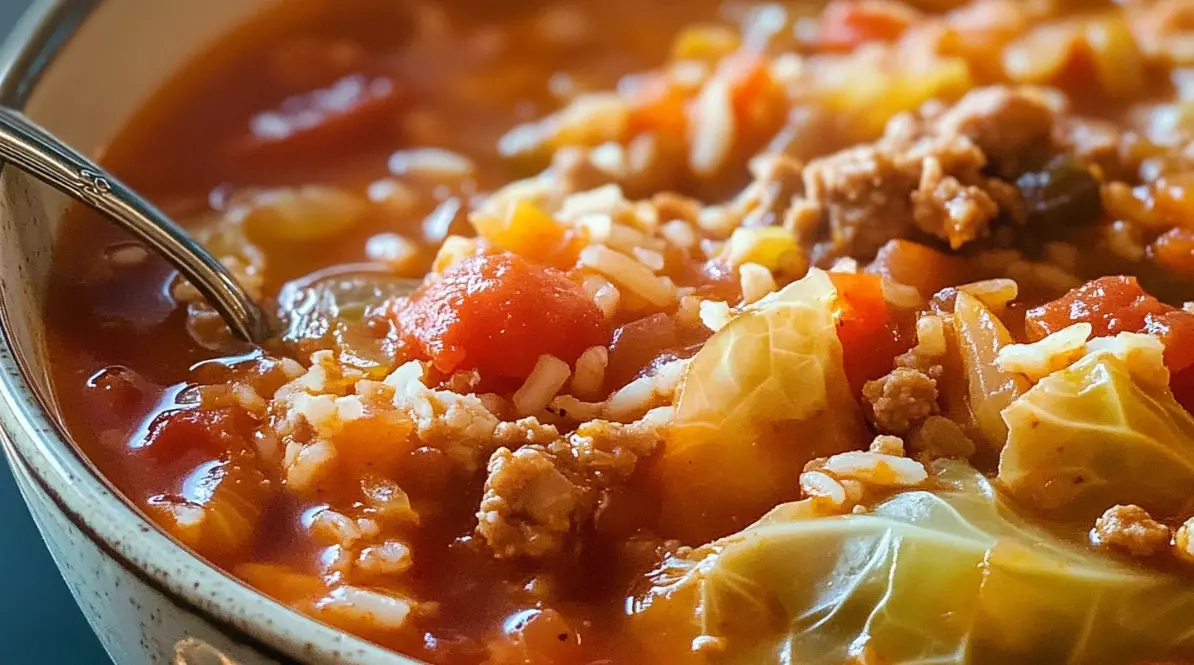Stuffed cabbage soup is a hearty, warming dish that captures the essence of traditional stuffed cabbage rolls but simplifies the preparation process. This beloved comfort food brings together cabbage, ground meat, rice, and tomatoes in a rich broth, creating a flavorful and satisfying meal. The roots of stuffed cabbage soup can be traced to the traditional cabbage rolls, a dish that has been enjoyed for centuries across various cultures, particularly in Eastern European countries like Poland, Hungary, and Romania.
Stuffed cabbage rolls are typically made by filling cabbage leaves with a seasoned mixture of ground meat and rice, then simmering them in a tomato-based sauce. The transformation into soup was likely a practical evolution, allowing cooks to enjoy the flavors of stuffed cabbage with less labor-intensive preparation. In soup form, the ingredients blend together beautifully, offering the same savory taste without the need to individually wrap cabbage leaves.
As the colder months approach, stuffed cabbage soup gains popularity due to its comforting warmth and nourishing ingredients. The blend of cabbage, meat, and tangy tomato base makes it ideal for a hearty meal that satisfies both body and soul. Its simple preparation and long-standing tradition make it a timeless dish that’s cherished by many.
History and Cultural Significance of Stuffed Cabbage
Stuffed cabbage is a dish that boasts deep cultural significance, with variations found in many parts of the world. In Eastern Europe, where stuffed cabbage is a staple, the dish is known as golabki in Poland, sarmale in Romania, and holubtsi in Ukraine. In these countries, stuffed cabbage rolls are often served at family gatherings, celebrations, and holidays, symbolizing warmth, hospitality, and shared traditions.
The dish has also made its way to the Mediterranean and Middle Eastern regions, where variations like dolma use cabbage or grape leaves as wrappers for spiced meat and rice mixtures. Over time, stuffed cabbage rolls evolved into stuffed cabbage soup, likely as a way to simplify preparation while retaining the rich, savory flavors that make the dish so beloved.
Cabbage itself is a significant ingredient in many cultures due to its affordability, availability, and nutritional benefits, cementing stuffed cabbage and its soup variation as both a practical and cherished meal across generations.
Key Ingredients in Stuffed Cabbage Soup
The foundation of stuffed cabbage soup is its simple yet flavorful ingredients, which are also common in many traditional cabbage roll recipes. The core ingredients include:
- Cabbage: The star ingredient, offering texture, flavor, and a host of nutrients. Green cabbage is most commonly used, but Savoy cabbage can add a more delicate texture.
- Ground Meat: A mix of ground beef and pork is traditional, but alternatives such as ground turkey or chicken can be used for lighter versions.
- Rice: White rice adds bulk and texture, though brown rice can be substituted for a healthier, whole-grain option.
- Tomatoes: Canned tomatoes, tomato sauce, or fresh diced tomatoes form the base of the soup. The acidity from the tomatoes balances the rich flavors of the meat and cabbage.
- Broth: Beef or chicken broth enhances the savory flavors and provides the liquid base.
- Seasonings: Garlic, onions, salt, pepper, paprika, and bay leaves are standard seasonings, with some recipes also including dill or thyme for extra flavor.
Alternative Ingredients:
- For a vegetarian version, replace meat with plant-based alternatives like lentils or tofu crumbles.
- Those following a low-carb diet can substitute rice with cauliflower rice for a keto-friendly version.
- Gluten-free variations are easy by ensuring no gluten-containing additives in the broth or seasonings.
Nutritional Benefits:
- Cabbage is rich in vitamins C and K, fiber, and antioxidants, known for supporting immune health and digestion.
- Lean proteins from the ground meat provide essential amino acids and help keep you full longer.
- Tomatoes offer lycopene, an antioxidant linked to heart health.
Choosing the Right Meat for the Soup
Selecting the right meat is crucial for achieving the desired flavor and texture in stuffed cabbage soup. Here are some popular options:
- Ground Beef: A classic choice for stuffed cabbage, providing a rich and savory flavor. A lean cut (80/20) offers a balance of flavor and less grease.
- Ground Pork: Often mixed with beef in traditional recipes, pork adds a subtle sweetness and tenderness.
- Ground Turkey or Chicken: For a lighter version, turkey or chicken offers lower fat content while still delivering a hearty taste.
Tips for Meat Selection:
- Combining beef and pork creates a more complex flavor profile.
- For a leaner soup, use ground turkey, but add extra seasonings to avoid blandness.
- Sauté the meat with onions and garlic for maximum flavor development before adding it to the soup.
Preparing the Soup: Step-by-Step Guide
Step 1: Prep the Ingredients
- Chop the Cabbage: Remove the core and chop the cabbage into bite-sized pieces.
- Cook the Rice: If using uncooked rice, parboil it ahead of time.
- Brown the Meat: In a large pot, brown the ground meat (beef, pork, or turkey) with diced onions and garlic until fully cooked. Drain excess fat.
Step 2: Build the Soup Base
- Add the Tomatoes: Pour in crushed tomatoes or tomato sauce, followed by diced fresh tomatoes if desired.
- Incorporate the Broth: Add beef or chicken broth to the pot, ensuring there’s enough liquid to cover all the ingredients.
Step 3: Add the Cabbage and Rice
- Stir in the Cabbage: Mix in the chopped cabbage and cooked rice, allowing them to absorb the flavors of the broth.
- Season the Soup: Add salt, pepper, paprika, and bay leaves. Taste and adjust seasoning as needed. Optional additions include a teaspoon of sugar to balance tomato acidity or a splash of vinegar for tanginess.
Step 4: Simmer
- Bring the soup to a boil, then reduce heat to low and cover. Let the soup simmer for 30-40 minutes, or until the cabbage is tender and the flavors have melded.
Alternative Methods:
- For a slow-cooker version, combine all ingredients in the slow cooker and cook on low for 6-8 hours.
- In an Instant Pot, brown the meat using the sauté function, then add remaining ingredients and pressure cook for 15 minutes.
Variations on the Recipe
Stuffed cabbage soup can be easily adapted to suit various tastes and dietary needs:
- Regional Variations: Some regions, like Poland and Hungary, add sauerkraut for extra tang and complexity. Others may use more aromatic spices like allspice or caraway seeds for deeper flavors.
- Vegan/Vegetarian Option: Replace the meat with plant-based protein like lentils, chickpeas, or a meat substitute. Increase the amount of cabbage and vegetables like carrots, celery, or zucchini to bulk up the soup.
- Low-Carb/Keto: Substitute rice with cauliflower rice, which adds bulk without the carbs. Reduce the tomato content if aiming for a very low-carb version.
- Spicy Version: Add red pepper flakes, diced jalapeños, or a dash of hot sauce for those who enjoy some heat. Alternatively, smoked paprika can provide a deeper, more subtle spice.
This flexibility allows the dish to cater to various preferences while still preserving its comforting, traditional flavor.
Cooking Tips for a Perfect Stuffed Cabbage Soup
To ensure the best possible stuffed cabbage soup, follow these cooking tips:
- Texture of the Cabbage: If you prefer softer cabbage, chop it finely and allow the soup to simmer longer. For more crunch, cut the cabbage into larger chunks and cook for a shorter time.
- Meat Texture: Browning the meat with onions and garlic adds a rich flavor. Make sure to drain any excess fat to avoid a greasy broth.
- Thickening or Thinning the Soup: For a thicker consistency, add extra tomato sauce or cook uncovered to reduce the liquid. If it becomes too thick, simply add more broth or water until the desired consistency is reached.
- Acidity Control: Tomatoes can make the soup slightly acidic. To balance this, add a small amount of sugar or a splash of heavy cream to round out the flavors.
Serving Suggestions and Pairings
Stuffed cabbage soup is hearty on its own, but it pairs beautifully with complementary side dishes:
- Bread: Serve with a crusty loaf of bread, such as sourdough or rye, to soak up the flavorful broth.
- Side Dishes: For a complete meal, pair the soup with mashed potatoes, roasted vegetables, or a light green salad.
- Beverages: For a traditional pairing, opt for beer, such as a Czech or Polish lager. For wine, a light red like Pinot Noir or a crisp white like Riesling works well. Non-alcoholic options like sparkling water or herbal teas also complement the soup.
Storing, Freezing, and Reheating
Stuffed cabbage soup stores and reheats well, making it perfect for meal prep:
- Storing: Keep the soup in an airtight container in the refrigerator for up to 4 days. The flavors often deepen after a day or two, making leftovers even more delicious.
- Freezing: Portion the soup into freezer-safe containers, leaving space at the top for expansion. It can be frozen for up to 3 months. To reheat, thaw in the refrigerator overnight and warm on the stovetop or microwave.
- Reheating: When reheating, stir the soup well to redistribute the ingredients. If the soup has thickened, add a little water or broth to restore its original consistency.
Nutritional Benefits of Stuffed Cabbage Soup
Stuffed cabbage soup is not only a hearty and comforting dish, but it’s also packed with valuable nutrients. A typical serving of stuffed cabbage soup offers a balance of protein, fiber, and vitamins while remaining relatively low in calories. Here’s a closer look at its key nutritional components:
- Cabbage: Rich in vitamin C and vitamin K, cabbage is an excellent immune booster and supports bone health. Cabbage is also high in fiber, which promotes digestion and helps regulate blood sugar levels.
- Ground Meat: Whether using beef, pork, turkey, or a plant-based alternative, the protein content in this soup helps build and repair muscle while keeping you full longer. Using lean meat can make the soup heart-healthy by reducing saturated fat content.
- Tomatoes: Loaded with lycopene, a powerful antioxidant, tomatoes promote heart health and reduce inflammation. They also provide additional vitamins, like vitamin A and potassium.
- Rice or Alternative Grains: The rice in the soup provides energy through carbohydrates and contains essential minerals. For whole grain options, brown rice offers higher fiber, further aiding digestion.
Beyond its nutritional content, this soup can help aid weight management by being filling while low in calories, making it an excellent choice for those looking to maintain or lose weight. The high fiber and nutrient density promote a feeling of fullness, making it a nourishing, wholesome meal.
Dietary Adjustments for Special Needs
Stuffed cabbage soup is versatile and can easily be modified to accommodate various dietary restrictions:
- Gluten-Free: Ensure the broth used is gluten-free, and swap out any added grains like barley for certified gluten-free grains or omit them altogether.
- Dairy-Free: Since the recipe doesn’t inherently include dairy, it’s naturally dairy-free, though adding cream or cheese can be avoided or replaced with plant-based alternatives.
- Low-Sodium: To make the soup low-sodium, use a low-sodium broth and reduce or omit additional salt. Opt for fresh tomatoes over canned, which often contain added sodium.
- Low-Fat: Choose leaner cuts of meat, such as ground turkey or lean beef. Reducing or omitting the oil used to brown the meat can further reduce fat content.
- High-Protein: Add extra meat or substitute a portion of the rice with legumes like lentils or chickpeas to increase the protein content.
International Variations of Cabbage Soups
Cabbage soup has been adapted and cherished by many cultures around the globe, each adding its unique twist. Here are a few variations:
- Borscht (Eastern Europe): While primarily known as a beet-based soup, some versions of borscht include cabbage and share similarities with stuffed cabbage soup. Borscht’s rich broth, often made with beef or pork, aligns with the hearty, satisfying nature of stuffed cabbage soup.
- Kapusniak (Poland and Slovakia): A popular sour cabbage soup made with sauerkraut, kapusniak adds a tangy flavor profile. It’s similar to stuffed cabbage soup but emphasizes the fermented aspect of cabbage.
- Sarma (Balkan region): Sarma typically refers to stuffed cabbage rolls, but in many Balkan regions, these flavors are also adapted into a soup format. This version often includes smoked meats and paprika for a robust, smoky flavor.
- Shchi (Russia): A traditional Russian soup made with cabbage, meat, and a broth base, shchi closely resembles stuffed cabbage soup. It can be either sour (with sauerkraut) or fresh (with green cabbage) and includes root vegetables like carrots and potatoes.
Each of these global variations reflects how cultures have adapted cabbage-based soups using local ingredients and techniques while maintaining the same core principles: warmth, nourishment, and comfort.
Frequently Asked Questions (FAQs)
1. Can stuffed cabbage soup be made ahead of time?
Yes, stuffed cabbage soup is an excellent make-ahead dish. The flavors often deepen as it sits, making it even more delicious the next day. Store it in the refrigerator for up to 4 days.
2. How long does stuffed cabbage soup last in the refrigerator?
Properly stored in an airtight container, stuffed cabbage soup will last for 3 to 4 days in the refrigerator. Be sure to reheat it thoroughly before serving.
3. Can I make stuffed cabbage soup in a slow cooker?
Absolutely! To make in a slow cooker, simply brown the meat first, then add all ingredients to the slow cooker and cook on low for 6-8 hours or on high for 4-5 hours.
4. What is the best type of cabbage to use for the soup?
Green cabbage is the most common choice, but Savoy cabbage can be used for a more delicate texture. Napa cabbage is also an option for a softer, sweeter flavor.
5. How do I thicken or thin the soup to my liking?
To thicken the soup, allow it to simmer uncovered to reduce the liquid, or add a bit of tomato paste. To thin the soup, simply add more broth or water until the desired consistency is reached.
6. Is stuffed cabbage soup suitable for freezing?
Yes, stuffed cabbage soup freezes well. Freeze in individual portions for convenience and consume within 3 months for the best flavor and texture.
7. How can I make the soup spicier?
To add spice, include ingredients like red pepper flakes, cayenne pepper, or a splash of your favorite hot sauce. You can also add diced jalapeños for extra heat.

Stuffed Cabbage Soup
Description
This stuffed cabbage soup is a simplified, comforting version of the classic stuffed cabbage rolls. It’s packed with tender cabbage, hearty ground meat, rice, and a rich tomato-based broth, bringing together all the flavors of stuffed cabbage rolls without the labor-intensive preparation. This one-pot meal is perfect for cold winter days and is a family favorite, thanks to its savory, filling, and wholesome nature. With easily customizable ingredients, this soup can also be adapted for various dietary needs.
Ingredients
- 1 tablespoon olive or avocado oil
- 1 1/2 pounds ground beef (I like to use 85% lean)
- 1 onion, diced
- 1 green bell pepper, diced
- 1 small head of cabbage, cored and coarsely chopped (or use 2 bags of pre-shredded coleslaw)
- 1 28–ounce can of crushed tomatoes
- 6 cups beef stock or broth
- 1 bay leaf
- 1 teaspoon dried dill weed
- 2 teaspoons paprika
- Dash of Worcestershire sauce
- 1/2 cup uncooked rice
- v8 juice or water to thin the soup if it gets too thick
- Salt and Pepper
Instructions
- In a large stock pot or Dutch oven, heat oil over medium heat. Add ground beef, onion, and bell peppers. Season with a big pinch of salt and pepper. Cook until beef is browned and cooked through and vegetables are soft and slightly golden.
- Add chopped cabbage, tomatoes, stock, bay leaf, dill, paprika and Worcestershire sauce. Bring to a boil, then reduce to a simmer. Simmer, uncovered for 45 minutes, or until cabbage is just tender.
- Add rice and simmer for another 30 minutes.
- If the soup is too thick, thin it down with v8 juice or water
- Season to taste with salt and pepper.
Notes
- Cabbage: Green cabbage is typically used in this recipe for its hearty texture and flavor. However, if you want a more delicate texture, Savoy cabbage is a great alternative. Napa cabbage can also work for a slightly sweeter, softer taste.
- Meat: Traditionally, ground beef and pork are used for a richer, more flavorful broth. For a leaner option, ground turkey or chicken can be substituted. If you prefer a vegetarian version, use plant-based meat alternatives or add more vegetables and legumes for texture.
- Rice: White rice adds bulk and a mild flavor, but you can substitute brown rice for a whole-grain option. If you’re following a low-carb or keto diet, cauliflower rice works perfectly as a substitute.
- Tomatoes: Canned crushed tomatoes are commonly used, but you can also use fresh diced tomatoes or tomato sauce. The acidity from the tomatoes balances out the richness of the meat and adds brightness to the soup.
- Broth: Beef broth is ideal for a robust, savory flavor, but chicken or vegetable broth can be used if preferred. For a richer broth, you can add a tablespoon of tomato paste or even a splash of red wine.
- Seasoning: Garlic, onions, paprika, salt, and pepper are essential seasonings. Adjust according to taste, and feel free to experiment with other herbs like thyme, dill, or parsley for additional flavor complexity. If the soup is too acidic, add a teaspoon of sugar or honey to balance the flavors.




